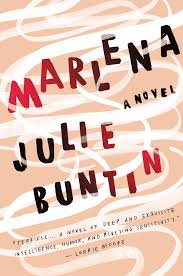
News
Summers Will Not Finish Semester of Teaching as Harvard Investigates Epstein Ties

News
Harvard College Students Report Favoring Divestment from Israel in HUA Survey

News
‘He Should Resign’: Harvard Undergrads Take Hard Line Against Summers Over Epstein Scandal

News
Harvard To Launch New Investigation Into Epstein’s Ties to Summers, Other University Affiliates

News
Harvard Students To Vote on Divestment From Israel in Inaugural HUA Election Survey
‘Marlena’ A Strong Warning For Teens
3.5 Stars

“Marlena” by Julie Buntin is a better warning about the dangers of drugs and alcohol than any high school health class could be. The book describes the life of Cat, a girl who lived a life of privilege before her parent’s divorce, and her friendship with Marlena, a girl two years Cat’s senior and heavily involved in underage drinking and drug use. When Marlena enters her life, Cat changes from a preppy school girl to someone just looking for her next cigarette. Once Marlena is found dead, less than one year after meeting Cat, Cat is never the same.
This novel shows more than just the obvious effects of drugs and alcohol—such as rotting teeth and overdosing—that are so often used to scare teens away from these bad habits. “Marlena” describes how these vices can both end a life too soon and also shape another life forever. Buntin provides readers with a full view of Marlena and Cat’s lives as teenagers getting drunk and high, intermittently interrupted by glimpses of Cat as an adult with a steady job and a husband. Although the most depressing parts of the novel are those that detail Marlena and Cat’s antics—which involve drinking and smoking instead of taking part in healthier teenage activities such as going to school—Buntin makes sure to emphasize the lasting effects of drugs and alcohol, which are dismal at best, in her depiction of Cat, who still struggles with alcohol as a grown woman, even after Marlena’s influence is long gone.
Buntin is not afraid to hit the reader over the head with her message. One night when the two girls are drunkenly talking, Marlena admits to Cat that “her life felt like a sentence, that it had been barreling down on her since she could first speak, that it really wasn’t much of a life at all.” Smoking and drinking influence Cat long after Marlena’s death. During their time together, Cat struggles with her self-image and constantly compares her body to Marlena’s. As an adult, Cat is still an alcoholic. Despite the fact that her husband disapproves, she still wakes up in the morning “already imagining the moment, that late afternoon turn, when it would again be appropriate to drink.” This portrayal of the future of those who partake in drinking and drugs in high school is the scariest part and one often left out of typical discussions during health class lectures condemning these activities. Since the entirety of the novel deals with issues of drugs and alcohol as well as their negative effects, there is no way for the reader to escape the dismal existence of Cat and Marlena. Buntin forces the reader to see how these vices can ruin lives.
Buntin also effectively addresses other issues adolescents face by depicting certain scenes in an uncomfortably intimate way, particularly as Cat struggles with her developing sexuality. Cat was a virgin before she met Marlena. Marlena, in turn has sex with her boyfriend and trades sexual favors with a man her father’s age in exchange for pills and cigarettes, which leads to Cat feeling childish in comparison. Though she initially looks forward to her first sexual encounter, when it finally happens with Marlena’s ex-boyfriend, the scene is painfully awkward. Cat describes being “ashamed of desire writ large, of [her] body, of his body, of the dumb way we were moving, of what Marlena would think if she saw, of the fact that I didn’t much want this.” Buntin is clearly making this scene excruciatingly uncomfortable on purpose in order to portray the issues that arise when girls begin to experiment sexually in a toxic environment riddled with drugs.
Throughout the novel, Cat employs a simple, but effective, inner-dialogue. Buntin writes these scenes with short sentences that are wrought with pain. In one poignant moment, Cat thinks, “The thing is, Marlena, I’ve messed a lot up. But every day I get to try again.” Because the reader has access to the inner thoughts of a grown-up Cat, Buntin is able to write with a nostalgic style that is emotional, yet simplistic.
Buntin’s greatest achievement is writing a story through the eyes of a teenager in a style that feels true to Cat’s young age without sounding childish. Buntin easily portrays Cat’s insecurities and her desire for Marlena’s attention without coming across as whiny. Cat describes Marlena as “abrupt in a way [she] always associate[s] with rude people, but bestow[s] a kind of brightness on whatever [catches] her interest—if it happen[s] to be you, nothing felt more sublime.” Due to Buntin’s mature writing style, “Marlena” is perfect for an adult audience despite the fact that stories starring teenagers are often relegated to the Young Adult genre.
“Marlena”’s painful story works because it is also brutally honest. It successfully scares off teens who are tempted by drugs and alcohol but does not feel preachy because Buntin never tells her readers to avoid this lifestyle. She simply gives a clear portrayal of the different effects that drugs and alcohol can have on those who abuse these substances. It just so happens that these portrayals can scare anyone, especially a young person, who is considering trying drugs or excessively drinking.
—Staff writer Caroline E. Tew can be reached at caroline.tew@thecrimson.com.
Want to keep up with breaking news? Subscribe to our email newsletter.
